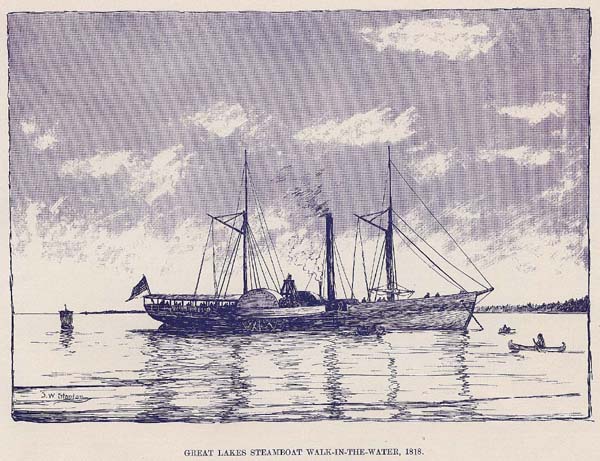
The Story of Myeerah

Isaac and Myeerah Zane* S.S. Walk-in-the Water, 1818-21
The name Myeerah ("My-EAR-uh") has a family connection and an apt nautical meaning. Myeerah, a Wyandot Indian, was the owner's great-great-great-great-great-great grandmother. To add to its appeal as a vessel name, Myeerah means "Walk-in-the-Water." There is a well-documented story about Myeerah. It begins before the American Revolution, during the westward movement when Ohio was a frontier populated by several Indian tribes. It centers on the Zane family--a well known family in Ohio history--and the Wyandot Indian tribe, part of the Huron nation that had been driven south from southern Ontario into the Upper Ohio valley by the Iroquois in the early 18th century.
In 1762 two brothers, Isaac and Jonathan Zane, aged 9 and 11, were kidnapped by Indians while returning home from school in what is now Moorefield, West Virginia. Isaac and Jonathan Zane had a sister, Elizabeth, who was the protagonist in Zane Grey's once-popular 1904 novel Betty Zane. Elizabeth's claim to fame was that during a 1782 Indian attack on Fort Henry at Wheeling, West Virginia, she transported gunpowder to the fort for the colonial defenders, at great risk to herself. Myeerah is a major character in that book.
Isaac and Jonathan were eventually taken to Detroit, then to what is now Sandusky, Ohio, on Lake Erie, where they lived with the Porcupine clan of the Wyandot tribe, specifically with the chief, Tarhé ("Tar-hay"), his French-Canadian wife, Ronyouqines La Durante, and their daughter, Myeerah: Ronyouqines was a French-Canadian girl who had been captured by the Wyandots. Myeerah's literal translation is "Walk-in-the-Water," a reference to the crane;she was called "White Crane" by settlers because of her fair skin. Tarhé's name translates as "The Tree," a reference to his tall and lean build.
In 1764 Jonathan, age 13, was ransomed and returned to his family. Tarhé had become particularly fond of Isaac and he refused to accept ransom for him. Isaac lived with the Wyandots as Tarhé's adopted son until 1771 when, at age 18, he left the Wyandots and returned to civilization. He eventually returned to the Wyandots, marrying Myeerah in 1777; he was 24 and she was 19.
Tarhé joined the other Ohio tribes in their alliance with the British during the American Revolution. In 1794, after the revolution, he fought against the Americans at the Battle of Fallen Timbers; the American forces decisively ended the Ohio Indians' hopes of maintaining their territory and integrity. A year later the Treaty of Greenville ceded large tracts of Indian lands in the upper Ohio Valley to America. The Indians were given hunting rights in perpetuity, but perpetuity ended forty-eight years later when, in 1843, the Wyandots were relocated to the Kansas Territory. The Treaty of Greenville was signed by Tarhé, among other Indian chiefs, and by Isaac Zane, who served as translator.
Following the Battle of Fallen Timbers, Tarhé's Wyandots became firm American allies. During the War of 1812 Tarhé, age 70, led his warriors on an expedition into Canada under the leadership of General William Henry Harrison, the future (but short-lived) President and the victor at the famous Battle of Tippecanoe. They defeated the British at the Battle of the Thames. At Tarhéís death in 1818--two years after Isaac and Myeerah--he was honored by the Ohio tribes and by Harrison, who publicly expressed his admiration for Tarhé as "the noblest of them all."
Isaac Zane served as an intermediary between colonial Americans and the Indian nations of the area. Isaac and Myeerah were the original settlers of Zanetown, now Zanesfield, Ohio, where they established the first fort in that area. Zanesfield (not to be confused with Zanesville, though named after the same family) is today a community of 250 souls. Isaac and Myeerah had three sons and four daughters, most of whom married Wyandots. Myeerah died in February 1816, Isaac eight months later.
The first steamboat on Lake Erie, launched in 1818, was named "Walk-in-the-Water" after Myeerah. She--the steamboat--sank in a gale in 1821, an ironic fate. The name Myeerah is still found in the Upper Ohio Valley.
A Vietnam-era military helicopter, the Sikorsky CH54, was named "The Tarhé."
And Myeerah's companion vessel, a 37-foot jet-powered Hinckley Picnic boat, is named Tarhé.
The name survives!
* This painting by artist Hal Sherman is at the Logan County Historical Society Museum in Bellefontaine, Ohio.
N.B. There was also a Huron chief named Myeerah who lived in the same period. He and our Myeerah are different people.
Links to Additional Information